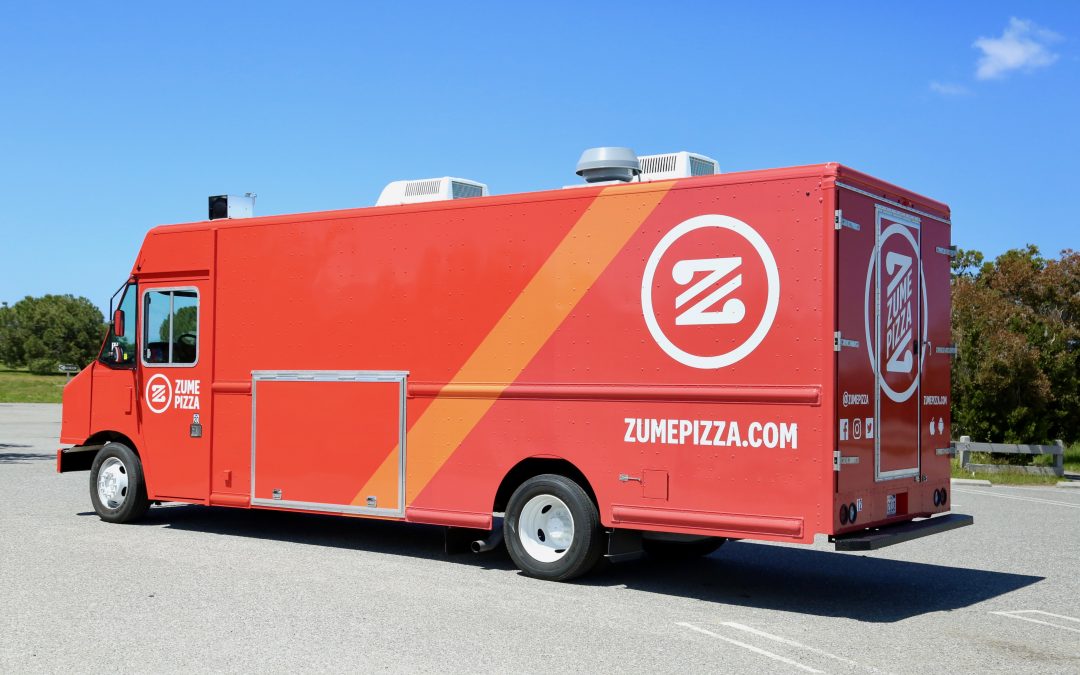An atypical California-based pizza brand is diversifying itself beyond delivering pizzas into developing mobile delivery kitchens and new packaging to reduce the environmental impact of meal delivery.
Originally started as a pizza restaurant that pivoted into mobile delivery kitchens (with &pizza, check it out HERE) Zume is now adding an entirely new dimension to the company with the goal of eliminating unnecessary packaging and making restaurant meal delivery less of a burden on the planet.
With all that as a backdrop, we had a quick conversation with Zume CEO and Chairman Alex Garden on how to make delivery packaging—and meal delivery in general—more sustainable. The conversation has been lightly edited for length.
 Food On Demand: What was the reason behind starting Zume, and how have you diversified into three seemingly disparate entities?
Food On Demand: What was the reason behind starting Zume, and how have you diversified into three seemingly disparate entities?
Alex Garden: Zume was born out of Zume Pizza. We set out to create a healthier and more sustainable way to make and deliver pizza. In the process, we uncovered a multitude of ways we could help other companies in the food industry. We created Zume Inc. to help food companies thrive in an increasingly delivery-enabled system while reducing waste and carbon emissions.
We offer food brands a full stack of hardware, software and packaging solutions to allow companies to grow in an on-demand system while making the world more sustainable. With increasing resource constraints, greater climate disruptions and the accelerating growth of the food-delivery industry, we have to find more sustainable ways to meet consumer demand across every part of the supply chain.
FOD: It’s easy to see the supply chain as something that’s out of reach and too complex to mess with. Is that a popular sentiment?
AG: As with any complex system with lots of moving parts, some people will look at it and think that it is too big of a problem to fix. Of course, this isn’t true. More often, what is needed is a catalyst that causes people to reevaluate a system. For the food supply chain, there are three major catalyzing forces. The first is that we’re moving from 7 billion to 10.5 billion people. Today there is no known agricultural system to meet this demand. The second is that the natural resources we use to grow our food are becoming ever more constrained due to poor resource management and climate change. As a result, we face significant societal risks around food security, water and climate security. The third catalyst is the advent of on-demand food. It is stretching the supply chain in a new way and in doing so is enabling people and companies, such as Zume, to not just reevaluate the food supply chain, but to effect positive change.
FOD: What are some improvements you encourage in terms of supply chain?
AG: Today’s global food system is remarkable in many ways, but it is inefficient and wasteful. Food waste is a $990 billion annual problem. Globally one-third of all food produced is never consumed (40 percent in the U.S.). That means that one-third of all the water and energy used to produce it, and resulting greenhouse gas emissions, is wasted. It’s no wonder that food production is one of the largest contributors to climate change. And in a world that is expected to grow to 10 billion people, the constraints on our resources will only grow. Improving the food supply chain is a hefty undertaking. The idea though, is pretty simple: What if we could eliminate much of this waste by better balancing the supply and demand of food?
The answer is to aggregate consumption data to help food companies better predict demand. By doing this, we can match our consumption with production and drive better resource decisions through the entire food-supply chain.
The rise of on-demand food delivery can help solve this problem because it provides real-time food consumption data straight from the source. The key to this solution requires being as close to the customer as possible to gather data around what food is needed, when and where. Ultimately, we will be able to use all that data on the supply side to better inform what and how much food to grow, produce and deliver, and when.
FOD: We’ve written about packaging, including talking with opposing industry competitors about what’s better—plastic or cardboard—and pollution experts about what terms like compostable or biodegradable actually mean for the environment. Some of that labeling seems rather disingenuous to this outsider. Do you agree?
AG: I don’t think it is disingenuous. Instead, it is the result of multiple people, agencies and entities all trying to find solutions to the problems we are facing together. With most problems, there won’t be a linear A-to-B answer, but rather many solutions that will help alleviate the problem of plastic packaging.
As more people become aware of these inconsistencies of labeling and the more research and development goes towards building sustainable solutions, the more the labels will be reconciled and easier for people to understand, be they inside or outside the industry.
FOD: What are the big opportunities in food packaging—what’s the lowest hanging fruit?
AG: The biggest opportunity in food packaging is compostable packaging, as it is a growing segment with consumers becoming increasingly aware of the detrimental effects of plastic on our environment. We’re also seeing growing regulations around plastics with more than 150 bans on single-use plastic around the world.
Similar to the automotive industry, the packaging industry has been locked in stasis for decades. Now, faced with the growing demand for sustainable solutions, we are seeing technological advances in sustainable packaging being made everyday, making new options like molded fiber work better for businesses’ bottom line and our planet.
FOD: With your acquisition of Pivot Packaging, how can you create cost-competitive alternatives to plastic?
AG: Prior to the introduction of Zume Source Packaging, compostable packaging could not mirror the adaptability and durability characteristics of plastic and has been up to 50 to 100 percent more expensive than plastic. Zume Source Packaging addresses these historical challenges by utilizing cutting-edge manufacturing technology and material science. The company has a proprietary set of formulas and forming and finishing processes to create moldable fiber that is intended to maintain the freshness and quality of perishable food compared to paper-based packaging.
The company is driving down the cost of molded fiber by innovating a new flexible manufacturing cell technology production technique that is capable of producing unique shapes with higher yields and faster cycle times than traditional manufacturing methods.
FOD: What’s your take on delivery’s overall impact on the environment? It’s not easy to calculate when you consider every little detail, like transportation, supply chain, changing customer behavior, etc.
AG: As on-demand delivery continues to grow, so too does the use of packaging. It’s critical that we get this right or today’s environmental problems associated with packaging will grow multi-fold. In China, for example, a market with far greater on-demand delivery penetration, they saw a 9x increase in packaging resulting from delivery.
This isn’t something that can be changed overnight, but it does open up new possibilities for the food supply chain as a whole as more people are working on solving the issues. For example, the rise of on-demand food has made people more aware of the detrimental effects of Styrofoam and plastic, and we have seen the market start to respond with more options and local governments begin to implement new policies to curb the use of single-use packaging and encourage the use of sustainable alternatives.
Another example is that on-demand food provides a clear real-time signal for what people are eating and what they want to eat. By using this data we can inform not just what food to grow, but [also] how much food to produce, as well as when and where to deliver it.
FOD: What could encourage more restaurants to compost?
AG: The amount a restaurant composts is dependent on the municipal composting infrastructure where the restaurant is located. Our experience has been that restaurants and all foodservice providers don’t want to create waste—it’s a cost burden for them. Most restaurants will want to compost if they can.
FOD: Are there any municipalities that require restaurants to compost?
There is a patchwork of regulatory requirements around composting. Some cities are stricter than others. San Francisco, for example, has the Mandatory Recycling & Composting Ordinance, which requires that trash is separated into one of three bins: recycling, landfill and compost. When it comes to food waste, that means the vegetable peelings in your kitchen or the leftover sandwich at the deli cannot go in the trash with everything else. They must be put in a separate organics bin. Then, that waste is composted and sold in bulk to farms and wineries around California. This law is part of the city’s goal to have all of its waste to be recycled or composted, rather than sent to landfills.
FOD: How big of an impact do you see as possible from franchised restaurants, in particular?
AG: They will have the largest impact given their scale. When franchised restaurants choose sustainable packaging, the high volume of packaging that they require to meet their needs enables manufacturers to leverage efficiencies of scale when producing the packaging. In turn, that brings down the price for independent restaurants that don’t have the same volume, but are also looking for sustainable options to provide their customers.
FOD: How about consumers? What is their role in encouraging positive changes among the stores and restaurants they patronize? Is it all just boycotts?
AG: Consumers speak with their choices in several ways, including boycotts. The most important role they have is choosing what to buy. For a long time, consumers’ choice was limited to plastic-only options. As more sustainable options become available, we are seeing people increasingly choose those options. People can also encourage positive change in the restaurants and stores that they patronize and also by encouraging brands via social networks that don’t have sustainable options to switch or offer sustainable alternatives.


